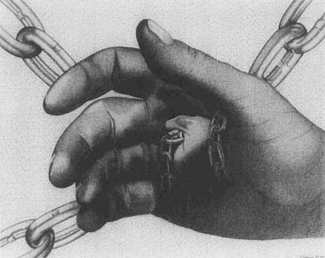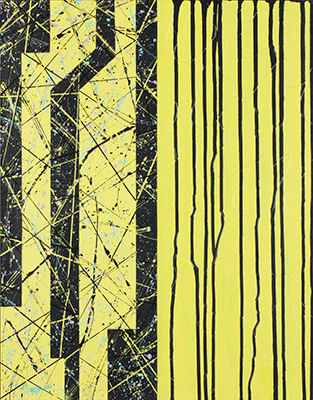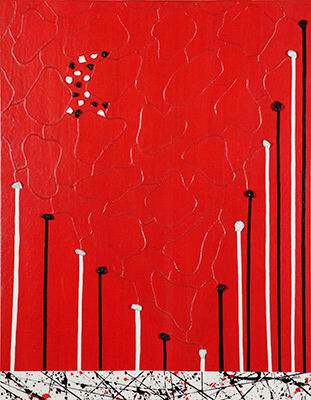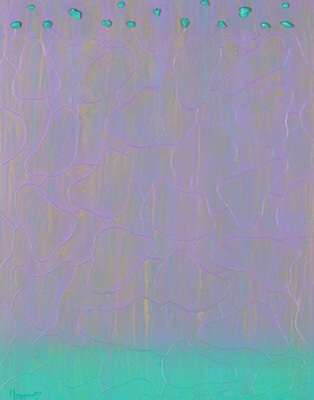MAKING
HIS MARK OUTSIDE OF THE BOX
My
name is Robert and I write about art. More so, I write about
the artists behind the art. On January 7th 2015, I attended
a lecture at Endicott College in Beverly, Massachusetts. The
course subject is designed to educate MBA students on Ethics
and Corporate Responsibility; a subject notably different
than what I normally report. I accepted the invitation from
the professor conducting the lecture, not quite knowing what
to expect. As I sat waiting for the class to begin my bewilderment
soon dissipated and was replaced with anticipation and excitement.
It was a few minutes before the guest speaker was slated to
talk and already an exhilarating sensation filled the air.
Whoever this person was, he possessed enough of a reputation
that even the college dean reserved his very own front-row
seat. By all indications one might think a former President
or public figure was about to make an appearance. Instead
we all waited for the instructor’s phone to ring, but
not from a politician or celebrity, rather from a man named
William A. Noguera. But who is William A. Noguera? I was about
to find out.
One minute before 11 am the telephone rang. The audio was
set to speaker allowing all in attendance to hear Noguera’s
voice for the first time. A large projector and screen were
set up at the front of the room.  On
the screen were images of art works and the space where William
Noguera resides; as he spoke different images appeared, and
a virtual art exhibition began. I now understood why I’d
been invited to be here. After the professor introduced him
to the class Noguera confidently addressed the group like
a seasoned expert, “Good morning ladies and gentlemen,
thank you for coming. My name is William A. Noguera and my
presence here today is an important contribution to this course
on Ethics and Corporate Responsibility. I am here as a reminder
to you that a crime, whether committed by an act of violence
or by cooking the books, is nevertheless a crime and will
land you in a prison cell.”
On
the screen were images of art works and the space where William
Noguera resides; as he spoke different images appeared, and
a virtual art exhibition began. I now understood why I’d
been invited to be here. After the professor introduced him
to the class Noguera confidently addressed the group like
a seasoned expert, “Good morning ladies and gentlemen,
thank you for coming. My name is William A. Noguera and my
presence here today is an important contribution to this course
on Ethics and Corporate Responsibility. I am here as a reminder
to you that a crime, whether committed by an act of violence
or by cooking the books, is nevertheless a crime and will
land you in a prison cell.”
For nearly an hour the entire class, myself included, was
riveted by Noguera’s every word. Other than the sound
of his voice, you could hear a pin drop. Noguera spoke of
fundamental ethics, individualism, boundaries, rules, laws,
fear and his personal experiences. Noguera also spoke about
his art and the philanthropic quest he believes in. Toward
the end of the lecture, he asked all of us to participate
in a small experiment. “Look at the person sitting next
to you,” he said. “Is he or she a criminal? You
can’t tell can you? The person who will tempt you into
compromising your ethics, who will seduce you with money and
power or simply offer the wrong way out of a difficult situation
won’t be wearing a villainous black cape and have a
pointy goatee. He will be a co-worker, a friend, or even your
boss. He won’t appear from out of the dark night. It
will happen during a company party, at happy hour, or while
you’re on a couples-vacation. In fact, it will be the
person you least suspect; the person sitting next to you.”
When the lecture ended we all got up to give a round of applause
and standing ovation. It was a moving and thought-provoking
experience.  After
the room emptied I approached Mr. Walt Pavlo, the class professor
who invited me to come listen to Noguera and his message.
While I was still speechless, Mr. Pavlo grinned and said,
“I told you he’s unique.”
After
the room emptied I approached Mr. Walt Pavlo, the class professor
who invited me to come listen to Noguera and his message.
While I was still speechless, Mr. Pavlo grinned and said,
“I told you he’s unique.”
I went home that afternoon unable to get the experience out
of my mind. On the surface, we see a man who creates art from
prison, but I needed to dig below the surface. How does a
man, from the confines of a prison cell, move me, and many
others, so profoundly? Noguera’s story held surprising
revelations; yes Noguera is in prison, worse, he is on death
row at the nation’s most notorious prison -- San Quentin.
Noguera is there for a crime he committed in 1983 at the age
of eighteen and has lived in a steel and concrete cage for
32 years. His case, though simply stated, is complex. While
Noguera is responsible for taking a life, it is imperative
we look at the circumstances that led to his incarceration
and to explore who the man truly is. I started my research
by opening my laptop and surfed my way to the website WilliamNoguera.com,
it’s noted as being the official resource about the
artist, his art and his life. It’s there that I read
every article written about Noguera starting at the time his
art gained nationwide attention and international recognition.
I was shocked that Noguera still remains in prison and wondering
why an appeal for a new trial had not been granted.
 The
circumstances of Noguera’s early life are heartrending.
Noguera grew up in a home where he was physically and emotionally
abused by both parents. Outside, he was the victim of even
more abuse; vicious beatings at the hands of gang-members
– because he was a target of racial discrimination for
being the only Colombian in a largely Mexican and black Los
Angeles County suburb. To cope, Noguera escaped into his imagination;
art has always been his refuge. To protect himself from these
attacks he enrolled in martial arts training where he excelled
and mastered the skill. In 1978 Noguera’s father introduced
him to anabolic steroids to improve his physical size, strength
and endurance for martial arts competitions. Noguera was only
13-years-old. The desired effects of the steroids were immediate;
with an increase in speed, power, and the ability to withstand
pain. But with the benefits came the harmful side-effects
of the drug; migraine headaches, mood swings and the outbursts
of “roid-rage” syndrome. By 1980 the small, painfully
awkward boy was all but gone. In his place was a 16-year-old
boy possessing the stature of a full-grown man; standing six
feet one inches tall and a one hundred and seventy pounds.
Noguera won the Hapkido Middleweight Championship by defeating
a man twelve years his senior.
The
circumstances of Noguera’s early life are heartrending.
Noguera grew up in a home where he was physically and emotionally
abused by both parents. Outside, he was the victim of even
more abuse; vicious beatings at the hands of gang-members
– because he was a target of racial discrimination for
being the only Colombian in a largely Mexican and black Los
Angeles County suburb. To cope, Noguera escaped into his imagination;
art has always been his refuge. To protect himself from these
attacks he enrolled in martial arts training where he excelled
and mastered the skill. In 1978 Noguera’s father introduced
him to anabolic steroids to improve his physical size, strength
and endurance for martial arts competitions. Noguera was only
13-years-old. The desired effects of the steroids were immediate;
with an increase in speed, power, and the ability to withstand
pain. But with the benefits came the harmful side-effects
of the drug; migraine headaches, mood swings and the outbursts
of “roid-rage” syndrome. By 1980 the small, painfully
awkward boy was all but gone. In his place was a 16-year-old
boy possessing the stature of a full-grown man; standing six
feet one inches tall and a one hundred and seventy pounds.
Noguera won the Hapkido Middleweight Championship by defeating
a man twelve years his senior.
In 1983 everything came crashing down for 18-year-old Noguera.
The years of abuse, the continuous use of anabolic steroids,
combined with grief and agony over the illegal abortion of
his nearly 20-week unborn baby proved to be too much. During
an argument with his then girlfriend’s mother, who boasted
about being responsible for the illegal abortion, Noguera
lost control, succumbed to the lethal explosion of “roid-rage”
syndrome that lurked underneath the surface. By the end of
the same year, Noguera was arrested, tried, then wrongfully
convicted of first-degree murder and sentenced to death.
Thirty-two years have passed. Noguera now 50-years-old fifty
years old, has dedicated himself to making a difference. He
gives to several charities, and lectures about his experiences
so that others may avoid making the same mistakes. And then
there is his art; he is an artist in full command of his power
to create visual poetry.
The following week I was scheduled to review the N. Dash Show
at the Hammer Museum in Los Angeles. It’s then that
I decided to take the opportunity to contact Melissa Ysais,
Executive Director of The William A. Noguera Trust in hopes
to visit Noguera’s work in person. After my introductory
email and telephone call, we scheduled an appointment for
the viewing of Noguera’s work.
On January 12th 2015 I entered the parking lot of the storage
facility in Los Angeles. Ms. Ysais greeted me with a warm,
dazzling smile and a firm handshake. As we made our way to
the third floor of the building, Ms. Ysais explained how she
has been able to keep Noguera’s work protected and in
pristine condition. She detailed the corrupt exploitations
by previous gallerists and dealers who embezzled from Noguera
by infringing on his intellectual property and The Trust’s
exclusive copyrights. I was astonished to learn from her that
Noguera’s pieces were stolen by these former art dealers
such as “The Ghost In The Material” (pictured
below) and “The Divine Proportion” which were
never recovered. Ms. Ysais described the meticulous cataloging
of Noguera’s work from photographing, copyrighting and
the diligent safeguarding processes that are involved in keeping
it inside a secure, climate-controlled environment.
 Ms.
Ysais fell quiet as I waited for her to negotiate the locked
door. Once open, we walked into the large unit where Noguera’s
work is kept. The room was well-equipped with racks containing
Noguera’s paintings. The far wall was occupied by a
large painting that caught my eye ;I couldn’t stop looking
at it. This painting pulled at my visual senses, demanding
to be seen. I found it difficult to listen or to concentrate
on what Ms. Ysais was saying at that moment, but in turning
toward her the spell broke.
Ms.
Ysais fell quiet as I waited for her to negotiate the locked
door. Once open, we walked into the large unit where Noguera’s
work is kept. The room was well-equipped with racks containing
Noguera’s paintings. The far wall was occupied by a
large painting that caught my eye ;I couldn’t stop looking
at it. This painting pulled at my visual senses, demanding
to be seen. I found it difficult to listen or to concentrate
on what Ms. Ysais was saying at that moment, but in turning
toward her the spell broke.
“You’ll want to experience the work without interruption.
I’ll leave you to it,” she said. “The racks
hold work that’s been arranged in chronological order.
Feel free to look at everything, including his studies which
are kept here in these bottom drawers just below the major
works.” Ms. Ysais handed me a pair of nitrile gloves,
“Here, you’ll want to put these on first,”
she said then exited the room.
Approaching the closest rack I carefully pulled out the first
piece. I recognized it as “Under Nails” created
in 2005, a hyper-realistic montage in ink stippling that leaves
no doubt Noguera is a first-rate creator of contemporary art.
I gently carried the piece over to the far wall then placed
it next to the painting from the series “Maximus Escapus.”
This is the piece that first captured my attention when I
walked into the room. Time stood still and I wondered if somehow
Noguera knew the exact moment I touched his work. ‘So
personal,’ is the thought that came to mind. Each one
of these marvelous works of art revealed the journey, the
solitude and the genius mind that created them. I don’t
know how or when it happened, but I found myself wiping tears
from my eyes; remembering joys and sorrows that I hadn’t
thought of in years. As I removed each piece from its place,
a rippling effect took place. The emotions came in waves,
and it happened over and over again; from nostalgia and joy
to agony and pain -- remembrances I’d experienced but
not felt in many years. It’s as if each painting was
starved to convey its power.
Later, Ms. Ysais returned, but I hadn’t noticed in time
to compose myself, my unconcealed emotions still clearly visible
on my face. She offered an empathetic smile saying, “It’s
like that for me too. His work pulsates with varying sequence
of emotions. And there’s no getting away from it.”
She was right of course.
I returned home from my trip to Los Angeles feeling under
the influence: the influence of Noguera’s life story
and the tremendous impact it has made on his art. Memories
long forgotten which only now returned to me. One such memory
was of the first time I stood before a Rothko many years ago
and what I experienced while I gazed upon it. Somewhere along
the way I forgot what the true power of art can do and what
it looks like. Noguera’s work reminded me of that. Noguera
also poses an interesting dilemma for many. Should his work
be overlooked because of what happened more than three decades
ago? Of course not. Perhaps we should appreciate the work
independent of the artist. No matter what else has transpired,
the power of true art cannot be constrained, silenced or caged.
It finds its way into the light and there it lives.
Noguera
is a visionary who makes me think of what an artist is actually
doing when he makes a work of art. In a 1978 essay by John
Berger called “The Work of Art,” he writes: “When
a painter is working he is aware of the means which are available
to him. These include his materials, the style he inherits,
the conventions he must obey, his prescribed or freely chosen
subject matter -- as constituting both an opportunity and
a restraint. By working and using the opportunity he becomes
conscious of some of its limits. These limits challenge him,
at either an artisanal, a magical or an imaginative level.
He pushes against one or several of them.” Berger is
writing about a painter, but what he writes holds true for
any artist.
Artists push the boundaries and in William Noguera‘s
case the boundaries are both virtual and literal; the results
are beautifully inspiring, evidence of a spirit roaming free
despite a body held prisoner.
Images
© William A.Noguera